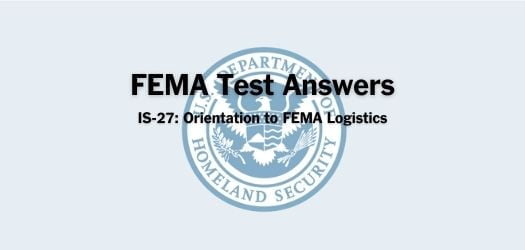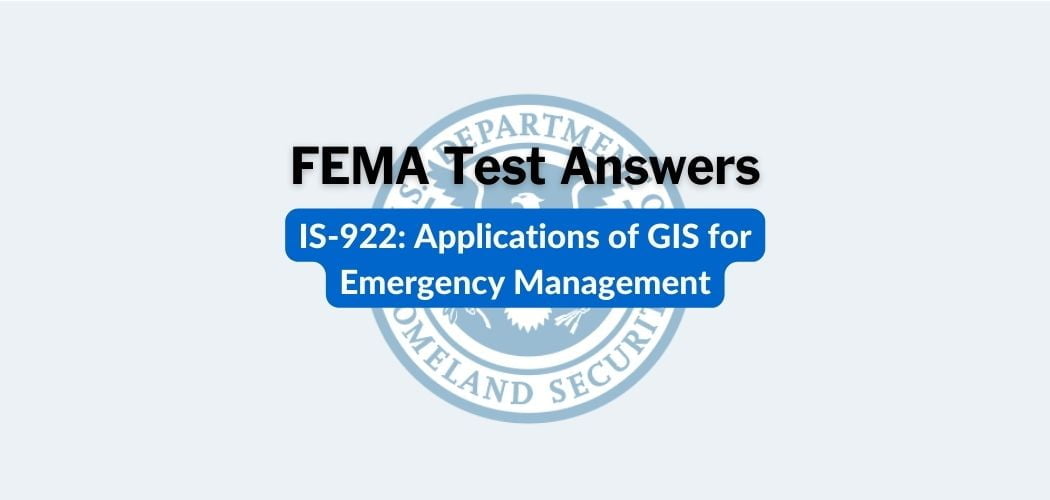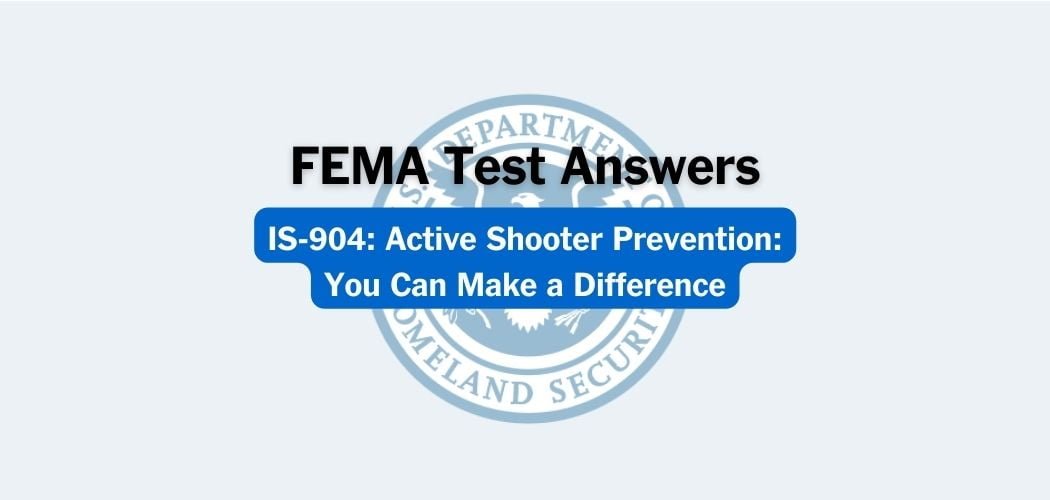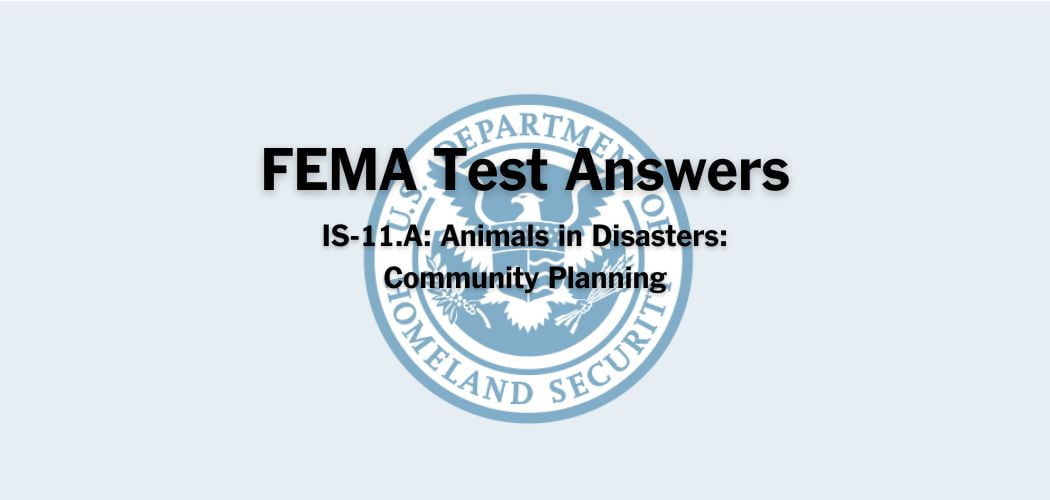Overview: The FEMA IS-1100.A course was published on 3/15/2016 to provide an overview of ICC coverage and eligibility and takes the learner through the claims process to gain a better understanding of this important coverage benefit.
Primary audience: FEMA IS-1100.A is for Insurance Agents, Adjusters, Floodplain Managers, Building Code Officials, Local Government Officials, and Property Owners.
FEMA IS-1100.A test answers
Each time this test is loaded, you will receive a unique set of questions and answers. The test questions are scrambled to protect the integrity of the exam.
1. To move your building out of harm’s way from flooding, the eligible compliance activity you should choose is _______.
A. Floodproofing
B. Relocation✅
C. Elevation
D. New Construction
2. True or False: When deciding which eligible ICC activity to choose, a policyholder should consider that ICC coverage has no additional deductible.
A. TRUE ✅
B. FALSE
3. True or False: Freeboard is a requirement to build above the local community’s Base Flood Elevation (BFE). All communities adopt a one-foot freeboard requirement for new construction in Special Flood Hazard Areas (SFHAs).
A. TRUE✅
B. FALSE
4. Which of the following does a policyholder need to initiate an ICC claim with the insurer?
A. Contractor’s estimate
B. Substantial damage determination letter✅
C. Building permit
D. The community’s floodplain management ordinance
5. After receiving a substantial damage determination letter from her community, Karla has decided to relocate her home, which had a pre-flood market value of $240,000 and has incurred $150,000 of flood damage. Relocation of the home will cost $120,000. What would be Karla’s ICC payment?
A. $75,000, which is half the amount of the current flood damage
B. $0, assuming that elevation would be a less expensive option
C. $60,000, which is half of the cost of relocating the home
D. $120,000, which is the relocation cost✅
E. $30,000, which is currently the maximum Increased Cost of Compliance payment allowed
6. True or False: The maximum combined amount a policyholder collects for both an ICC claim and the flood insurance loss payment cannot be greater than the maximum limits of coverage for the building type.
A. TRUE✅
B. FALSE
7. Ned and Mary’s home has been declared as substantially damaged by their community. They have discussed mitigation options with the community official that will comply with floodplain regulations. What should they do next?
A. Contact the initial claims adjuster for help deciding which eligible compliance activity to choose.
B. Obtain a contractor’s estimate for one or more eligible compliance activities.✅
C. Contact the ICC claims adjuster for help deciding which eligible compliance activity to choose.
8. True or False: The ICC claims adjuster confirms that the policyholder’s claim meets all ICC requirements, then provides the policyholder a building permit for work to begin.
A. TRUE ✅
B. FALSE
9. Who may grant a policyholder an extension to complete an eligible compliance measure?
A. State senator
B. FEMA administrator✅
C. Local official
10. Which of the following may be eligible for ICC coverage?
A. Buildings located in communities participating in the Regular Program✅
B. Units insured under a condominium unit owner policy
C. Buildings insured under the Group Flood Insurance Policy
11. What is the maximum ICC payment a policyholder can currently receive?
A. $20,000
B. $30,000✅
C. $10,000
D. $40,000
12. An initial claims adjuster is responsible for all of these tasks except?
A. Remits the policyholder’s claim to the insurer✅
B. Provides an ICC brochure to the policyholder
C. Completes the Adjuster Preliminary Damage Assessment (APDA) form
D. Contacts a licensed professional to complete an Elevation Certificate.
13. True or False: After inspection, the claims adjuster is required to submit daily reports of possible substantially damaged properties, which may qualify for ICC coverage, by completing the Adjuster Preliminary Damage Assessment (APDA) form and submitting the form to the NFIP Bureau and Statistical Agent.
A. TRUE✅
B. FALSE
14. Which eligible compliance activity involves making a building watertight through a combination of adjustments or additions of features that reduce the potential for flood damage?
A. Relocation
B. Elevation
C. Floodproofing✅
D. Demolition
15. True or False: A building’s repetitive losses from flooding are the only option that may be used to meet the substantially damaged criteria for ICC.
A. TRUE✅
B. FALSE
16. Who is responsible for regulating all development in designated Special Flood Hazard Areas (SFHA) in accordance with the NFIP and state and community floodplain management laws?
A. State official
B. FEMA administrator
C. Local official✅
D. Real estate developer
17. Which of the following is true about a Certificate of Occupancy?
A. The community provides a Certificate of Occupancy to policyholders as notice that their compliance measure complies with the local floodplain management ordinance.✅
B. Policyholders may request a Certificate of Occupancy from their community, ICC claims adjuster or any licensed professional who inspects their home.
C. Policyholders do not need to present a Certificate of Occupancy to their insurer to receive an ICC payment.
18. True or False: Policyholders whose buildings are located in the Special Flood Hazard Area (SFHA) may collect a higher ICC payment than those whose buildings are in a non-SFHA.
A. TRUE✅
B. FALSE
19. If the date of a policyholder’s underlying flood claim is August 12, 2014, the compliance measure must be completed by which of these dates?
A. February 12, 2017
B. August 12, 2018
C. August 12, 2016
D. August 12, 2020✅
20. True or False: All communities have a repetitive loss provision in their floodplain management ordinance.
A. TRUE
B. FALSE✅



